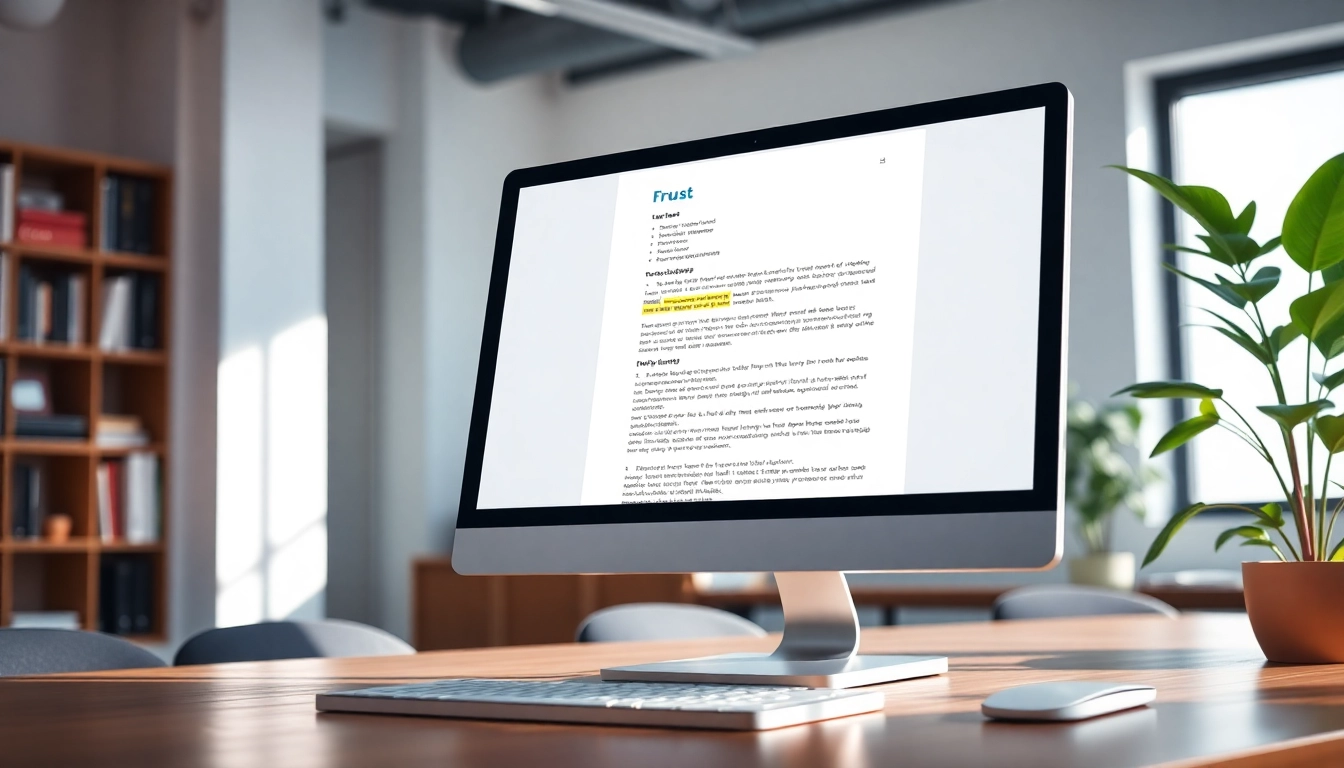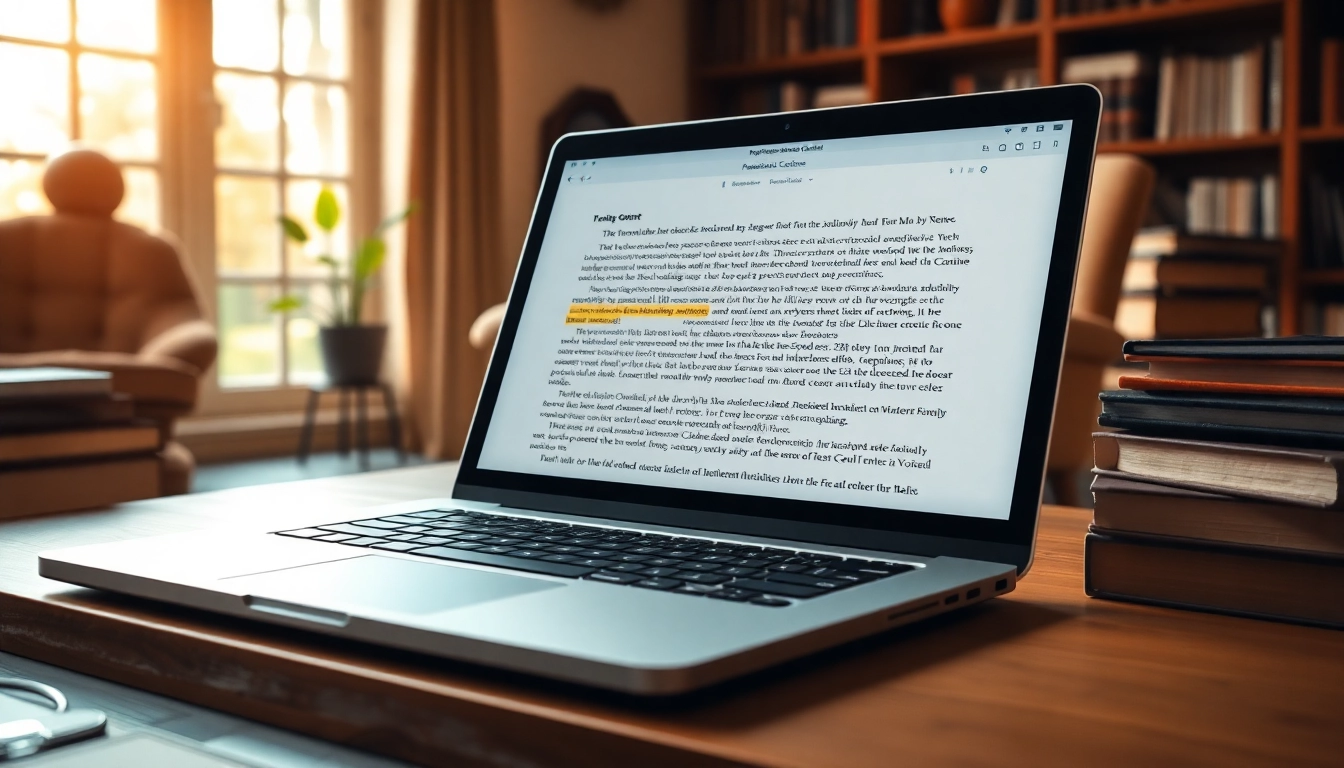Understanding Plagiarism Checker Technology
Definition and Importance of a Plagiarism Checker
In today’s information-driven society, the integrity of written work is paramount. A plagiarism checker is a digital tool designed to analyze text and identify instances of copied content. These tools serve an essential function in various contexts, including academic settings, professional writing, and content creation. The importance of a plagiarism checker lies not only in the prevention of intellectual dishonesty but also in maintaining the credibility of individuals and organizations.
The rising trend of content generation, coupled with the ease of access to online resources, has resulted in an increased risk of unintentional plagiarism. As such, employing a plagiarism checker can be a proactive measure to uphold standards of originality and ethical writing.
How Plagiarism Checkers Work: Algorithms and Processes
Plagiarism checkers utilize sophisticated algorithms to compare submitted content against vast databases of previously published material. The fundamental processes involved in plagiarism detection include:
- Text Analysis: The initial step involves decomposing the submitted text into smaller units, such as sentences and phrases, to facilitate comparison.
- Database Comparison: Checkers access extensive databases, including academic journals, articles, and internet sources, to find potential matches.
- Report Generation: After analysis, the tool compiles a report indicating the percentage of similarity, specific sources of matched content, and suggestions for paraphrasing or citation.
By utilizing natural language processing and machine learning, modern plagiarism checkers enhance their detection accuracy, making them crucial tools for anyone engaged in writing.
Common Types of Plagiarism Detected
Plagiarism can take many forms, and effective plagiarism checkers are designed to detect various types, including:
- Direct Plagiarism: Copying text word-for-word without attribution.
- Self-Plagiarism: Reusing one’s own previously published work as if it were new or original.
- Patchwork Plagiarism: Combining copied phrases from different sources into a new piece without proper attribution.
- Source-Based Plagiarism: Failing to provide proper citations for sourced material, therefore misrepresenting the ownership of ideas.
Being aware of these types can help users effectively utilize plagiarism checkers and improve their writing integrity.
Choosing the Right Plagiarism Checker
Key Features to Look For
When selecting a plagiarism checker, it is vital to consider several key features that enhance user experience and effectiveness:
- Database Size: A larger database increases the likelihood of detecting instances of plagiarism. Tools with extensive educational, academic, and internet-based sources provide more thorough checks.
- Report Details: Quality plagiarism checkers offer comprehensive reports that outline specific matches alongside their original sources, enabling effective attribution.
- User Interface: The tool should have a user-friendly interface, enabling users to navigate effortlessly and understand the results presented.
- Integration Capabilities: Compatibility with writing platforms and content management systems can streamline the process of checking for plagiarism, making it easier to maintain quality throughout the writing cycle.
Comparative Analysis of Free vs. Paid Options
Deciding between free and paid plagiarism checkers can be influenced by various factors, including budget, required functionality, and frequency of use. Understanding the differences is crucial:
- Free Options: Typically provide basic features, which may include simple text comparisons and limited database access. They can serve well for casual users; however, they may lack the comprehensiveness needed for extensive academic or professional applications.
- Paid Options: Offer a broader range of features, including detailed reports, advanced algorithms, and extensive databases of sources. They are generally more efficient at detecting intricacies in plagiarism and will serve frequent researchers, writers, and professionals better.
Individuals and institutions should evaluate their specific needs before making a choice between available options.
User Reviews and Recommendations
User feedback can provide valuable insights when selecting a plagiarism checker. Potential users are encouraged to look for reviews focusing on:
- Accuracy: How well does the tool perform in identifying potentially plagiarized content?
- Ease of Use: Is the checker intuitive and user-friendly?
- Customer Support: What support is available if issues arise, and how responsive is the service?
Gathering a broader consensus of experiences can inform a decision and likely yield better results.
Implementing a Plagiarism Checker in Academic Settings
Best Practices for Student Use
Students can benefit immensely from using a plagiarism checker, especially in academic writing contexts. Implementing best practices can optimize their effectiveness:
- Pre-Submission Check: Students should run their assignments through the plagiarism checker before submission to identify any potential overlaps or missed citations.
- Understanding Reports: It’s crucial that students learn to read and interpret the results provided by the checker effectively to understand areas of concern and improve their writing.
- Regular Monitoring: Incorporating regular checks into the writing process fosters a habit of integrity and attention to originality.
Integrating Plagiarism Checkers into Curriculum
Educators can integrate plagiarism checkers into the curriculum to foster academic honesty and support students in their writing endeavors:
- Training Sessions: Conduct workshops to educate students about the importance of originality in academic work and how to use plagiarism checkers effectively.
- Assignment Guidelines: Encourage students to use plagiarism detection tools as part of the writing process, outlining its importance in research and assignment integrity.
- Incorporation in Assessments: Consider requiring submission of a plagiarism report along with assignments to ensure students understand and value the principles of originality.
Ensuring Ethical Standards and Integrity
Maintaining academic integrity requires more than just plagiarism detection. Institutions need to foster an environment that emphasizes ethical writing practices:
- Clear Policies: Develop clear guidelines regarding plagiarism and its consequences to educate students about the significance of originality.
- Support Services: Offer resources such as writing assistance centers to help students understand citation practices and paraphrasing techniques.
- Encourage Original Thought: Engage students in exercises that promote critical thinking and creativity, reducing the temptation to plagiarize by generating their unique ideas.
Plagiarism Checker for Professional Writing
Utilizing a Plagiarism Checker in Content Creation
For professional writers and content creators, utilizing a plagiarism checker is an essential component of the writing process. Here are some effective methodologies:
- Submission Readiness: Before publishing content, run it through a plagiarism checker to ensure all material is original and properly cited.
- Collaborative Writing: In team projects, using a plagiarism checker can help maintain consistency in originality across contributions from different authors.
- Brand Credibility: Upholding high standards of originality in published content fortifies brand reputation and trustworthiness among audiences.
Maintaining Originality in Various Writing Genres
Different writing genres can involve unique challenges when it comes to originality. Writers can implement these strategies:
- Creative Writing: Novelists and poets should ensure that themes and ideas are expressed authentically while avoiding unintentional overlaps with existing texts.
- Technical Writing: In fields with established terminology, ensure clarity in expression while avoiding direct replication of other technical documents.
- Journalism: Journalists must be vigilant about giving credit to sources while presenting factual information. Using a plagiarism checker can highlight unintentional similarities in reporting.
Case Studies: Success Stories Using Plagiarism Checkers
Many professionals have experienced the benefits of using plagiarism checkers. Here are a few hypothetical case studies to illustrate their efficacy:
- Academic Institution: A university introduced plagiarism checkers into their writing curriculum, resulting in a significant decrease in confirmed cases of plagiarism over the semester.
- Publishing Company: A publishing house adopted plagiarism detection tools, which led to faster publication times due to fewer instances of copyright issues needing resolution.
- Content Agency: By using plagiarism checkers, a content agency improved client satisfaction rates, as clients were guaranteed 100% original articles.
Future Trends in Plagiarism Detection
Impact of AI on Plagiarism Checkers
The involvement of artificial intelligence in plagiarism detection enhances the accuracy and efficiency of these tools. Future revisions may include:
- Adaptive Learning: Advanced plagiarism checkers could learn from individual users’ writing styles, enhancing detection capabilities tailored to their specific patterns.
- Contextual Understanding: AI can offer context instead of just detecting similarity, helping users understand nuances between common terms and actual plagiarism.
New Developments in Detection Capabilities
As technology continues to evolve, plagiarism checkers are likely to incorporate cutting-edge features, including:
- Real-time Detection: Future tools may detect plagiarism in real-time as users write, providing instant feedback.
- Cross-Language Detection: Enhanced cheque processes could compare texts across multiple languages, increasing functionality for diverse writing communities.
Predictions for the Evolving Landscape of Plagiarism Detection
In conclusion, the field of plagiarism detection is poised for significant advancements, driven by technological growth and a heightened emphasis on content integrity. Potential developments may include:
- Wider Adoption: As awareness of plagiarism issues grows, more institutions and individuals may turn to plagiarism checkers, increasing overall demand.
- Integration with Other Tools: Expect broader integrations with writing assistants, content management systems, and research databases to streamline workflows.
The trajectory of plagiarism checkers promises a future where originality and ethical writing practices are enhanced through technology, fostering a culture of integrity in writing across various disciplines.















Leave a Reply